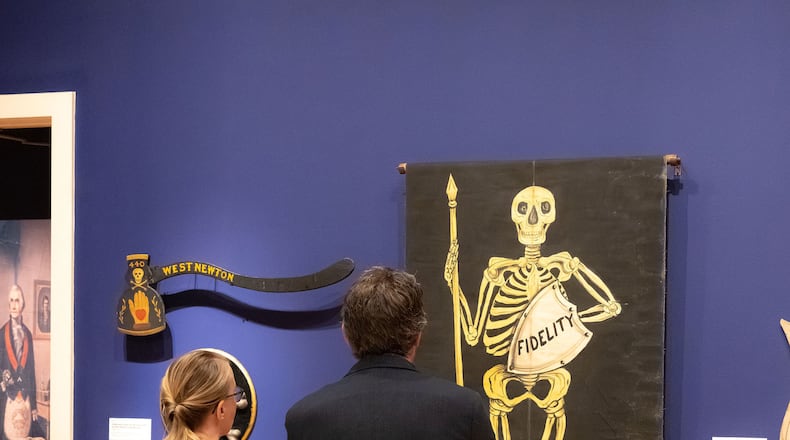“Mystery & Benevolence” is a collection of objects used for decades by the two organizations in their ritualized, often secret, practices. On display are scythes and skulls, costumes and banners, decorative furnishings. The exhibit will be on display through May 11.
“In the nearly 10 years since ‘Mystery and Benevolence’ first debuted at the American Folk Art Museum, this exhibition continues to enthrall viewers with the enigmatic symbols and rich imagery that gave many of these fraternal societies an intriguing shroud of mystery,” said Emelie Gevalt, the New York museum’s Deputy Director and Chief Curatorial and Program Officer. “The astounding art and objects in this exhibition are a testament to the self-taught artists and artisans whose vast contributions to early American material culture helped ingrain these societies into popular culture for generations.”
At first glance symbols like the skull and crossbones may be shocking and off-putting. But you’ll soon learn they were part of an initiation ritual designed to encourage members to care for one another in life and in death.
“People love this exhibit and are fascinated with the subject,” said Ann Glasscock, associate curator at the Taft. “It’s something you can’t see anywhere else. It’s mysterious because we don’t know 100 percent what goes on behind those closed doors. But these items tell you what goes on... up to a certain point. For both of these groups, serving the community and self-improvement is important.”
Meet the collectors
The artifacts come from the Kendra and Allan Daniel Collection. In the introduction to the exhibit catalog, Allan Daniel writes that these items were made to tell a story, convey a mood or teach a lesson and were rarely made by academic artists.
“Before social services were governmentally institutionalized, people established private fraternities that could provide for those needs,” he said. “This concept fascinated and propelled us to seek out objects that we felt were of artistic merit and deserved to be included in the category of folk art.”
One example? You’ll notice a heart design in many of the Odd Fellows artwork — often pictured as a heart in hand, an emblem of love and friendship.
“The iconic Odd Fellows symbol of the three-link chain, representing Friendship, Love and Truth, projects a simple, powerful message,” said Daniel.
Most of the items are handcrafted.
About the societies
Glasscock said when these groups were first created in America, the Masons were predominantly members of the upper class while the Odd Fellows tended to be middle class and work in diverse trades.
At the Taft, you’ll learn more about the history of the groups: the ways in which the Masons and Odd Fellows are organized, the various levels and degrees of membership and how their lodges are set up. Freemasonry had its origins in medieval stonemasons guilds in London in the 1700s with the American branch created in the 1800s.
The United Grand Lodge of England reports that worldwide membership now totals more than 6 million Freemasons, 1.1 million of whom are in North America. With more than 60,000 Masons and 430 local Lodges, Ohio has one of the largest Masonic memberships of any state in the country. Did you know George Washington was a Mason?
According to The Independent Order of Odd Fellows today there are more than 600,000 members in more than 10,000 lodges across 30 countries. It was established in the United States in 1819.
The original “brotherhoods” were developed by and for white men only. While the Taft exhibit looks at the richness and exclusivity of fraternal culture, it also shows how some of the members of excluded groups, including women and African American men, formed their own societies such as the Daughters of Rebekah and the Grand United Order of Odd Fellows.
What’s on display
Showcased are altars, uniforms and costumes. During the performance of Odd Fellows rituals, members don costumes to act out characters in a story in order to make the lessons come alive. Freemasons use regalia that indicates their levels and roles within the organization.
There are brightly painted signs, symbols and passwords that appear on a variety of objects. For example, American Odd Fellows initially used bow and arrow imagery to teach lessons of friendship. A bundle of sticks was a prop used to demonstrate that those who stand together are stronger than one man standing alone.
Another popular symbol is the beehive; the idea is that it represents industry and unity, working together toward a common purpose.
The tracing boards on display are decorated with symbols that help members learn about their various duties. They were originally traced onto the floor or a wall and then erased but Masonic lodges eventually commissioned illustrated charts.
It’s thought that the Pettibone Brothers Manufacturing Company of Cincinnati in 1867 may have produced banners on display. The company fabricated uniforms, costumes, hats, flags and banners for the military, firefighters, theaters, marching bands and fraternal organizations.
The Daniels spent 30 years amassing their unusual collection. “For my wife Kendra and me, fraternal art was considered an under-appreciated area in American folk art,” Allan said. “The hunt for these beautiful, often eerie, and sometimes outre objects has been visually enriching and exciting for us and we hope that it will be eye-opening and fascinating for those attending the exhibition.”
Credit: Washington as a Freemason, Strob
Credit: Washington as a Freemason, Strob
Credit: Masonic Shelf Clock, John Haley
Credit: Masonic Shelf Clock, John Haley
HOW TO GO
What: “Mystery & Benevolence: Masonic and Odd Fellows Folk Art,” presented by the American Folk Art Museum in New York and International Arts & Artists.
Where: Taft Museum of Art, 316 Pike St., Cincinnati
When: 10 a.m.–5 p.m. Wednesday–Monday through May 11
Admission: General admission is $15. Seniors pay $12. Tickets are free for children 17 and younger and military with ID. The museum is free on Sundays and Mondays.
More info: taftmuseum.org/mystery
About the Author






